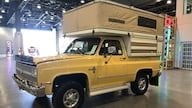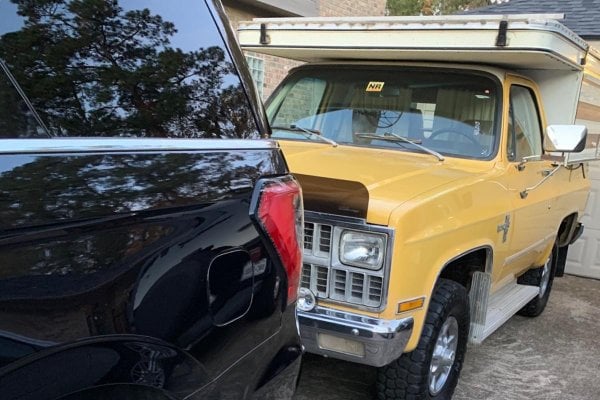Boonie said:
Zoomad,
I have no idea why it has taken me this long to discover your build. My build "81 Grandby on 91 Jeep YJ" is very similar to your build because our campers are mounted to the body siderails and have no wood floor pack. One of the elements I am concerned about in my build is weight. My target design GVWR is 5640. I noticed in your post #216 reference to a friends Blazer/camper grossing at 8000. Have you weighed yours? I noticed in post #21 your laminated 5/8 and 1/2 plywood for your overhead bed floor and in post #40 it looks like your cabinet framing is 3/4 plywood with 3/4 Oak facing and Oak doors. Also the lower locker/daybed is made of 3/4. As I get ready to build my cabinets I am thinking of ways to use only 1/2. I assume that you have had on problems with the cabinets, so I also assume you have no way of estimating if 1/2 would have been adequate in many places?
I look forward to reviewing your entire post, not only the build, but also your Colorado travels since I'm in Colorado also.
Boonie
Hey Boonie. Been following your build too as it's so different and unique. I've been enjoying your progress and glad to see you are back at it too!
Let me get into your questions. Weight is most certainly a factor but I wasn't hyper critical about shaving weight out of it, but more of finding new locations to put stuff to get the weight as low as possible to keep my center of gravity as close to stock as possible. Part of that savings was deleting the stock 3-way fridge (also because it sucks for what I do off road compared to a 12v compressor fridge). That got the fridge out of the side cabinet and down to the floor, without a major loss in floor space. I also deleted the stock water storage tank, because it also lived inside the cabinet above the bed rails. The stock two burner stove also got the axe due to it's height off of the floor and I didn't plan on cooking inside due to the small space and stinking up the entire interior. I do store my camp stove up there, but it's pretty lightweight and lacks the plumbing the old system did.
We got a little carried away with the construction side with the 3/4" plywood in the cabinet construction. We went that way for all out rigidity knowing I won't be only running down pavement and graded dirt roads. The stock pressed board construction with staples would not have survived long term with where I've taken the camper already. The doubling up of layers on the cab-over floor was more about supporting me than anything else. I'm a big dude so I didn't want the cab-over floor deflecting onto the roof of the cab when I'm catching Z's in the upper bunk. That's one area I sacrificed for strength over weight savings. So far that's paid off with zero contact between the two.
The blue camper I referenced at the 8,000 pound mark is my buddy's K10 pickup with a Phoenix camper. His gets called a Blazer camper more often than not so it's a pretty easy mistake to make. But that's where a big difference in weight comes in. Besides running a Big Block engine (all iron), one ton axles and winches on both ends, his being a pickup adds the fully contained cab and separate pickup box. His body weighs in more than mine (stock vs stock that is). Then the camper itself is fully contained with a floor pack and front wall. The Phoenix camper also has 10 gallons of onboard storage plus a hot water heater. He's a nut carrying more than he needs to, but he's like me on wanting to be over-prepared on long trips. So there's a few things that will naturally make his setup heavier than mine is. He's running an 8.1L big block that came from a class a motorhome with a 22,000 pound GVW so he's got more than enough power to pull the combo around with.
I've weighed mine prior to taking my first long trip with it in 2018. At the time I had a monster snowmaster fridge my co-pilot bought for the trip. I was 90% loaded for the trip and it came in around 6,300 pounds with me sitting inside. With my co-pilot onboard and the rest of his gear we were probably over 6,500 pounds going down the road. With my modifications to the suspension for the lift and off-roadability the camper's weight isn't too far off from what it was without it, but loaded to the gills for a week long trip. My goals of keeping the weight low so far has worked. The CG is a little higher than stock, but it's handled some wicked trails with steep inclines and declines that would surprise many. The spooky part is off-camber situations or side hills. But that's the nature of a heavy truck on large tires lifted 4" over stock. It's handling on the road isn't too far from what it was prior to the camper except for the more barn like aerodynamic qualities catching the wind. I've made an emergency lane change when a crazy chick in a BMW almost killed us on the 2018 desert trip where my buddy in the blue K10 swore he saw the left rear off the ground when I swerved to avoid her. But it stayed put and got us to the side of the highway safely. Both the on and off road ability I think really comes from my efforts to keep the weight low, suspension setup and Bilstein shocks.
In your build since you don't have the luxury of working on a heavier chassis like mine, using 1/2" plywood in construction shouldn't be a major loss in strength over the thicker stuff. I'd think about the cab-over floor still being fairly heavy due to load that you'll have up there. Where my factory particle board cab over floor wasn't swelled due to water damage it was 1" thick. That's thick but with no support in the center, I would not trust it to hold my weight. Due to the laminated construction of plywood I was confident it wouldn't bow at the thickness we ended up with. We were right on that.
Keep this in mind, GVWR is important to look at for the vehicle capacity. K5's usually only had 6,100 pound GVWR and I'm positive I blew past it. But that rating is based on stock 1/2 ton axles and stock springs, neither of which I have on mine anymore. So given the weight increase you are likely to have I'd also look at beefing up the suspension to handle the extra weight. I'm not sure you are going to be going silly off road nearly as much as I like to, so that may play in deciding between higher capacity springs that also lift the Jeep or adding something like air bags on the rear axle to supplement the stock spring rate without a lift. You may not want to make those changes to the suspension until the camper is finalized and you can get an actual value of weight vs what you think it may weigh.
Keeping weight in check and down low is a balancing act for sure. But a little extra effort planning now will give better results later when the vehicle out being driven.
Being in Colorado really gives me a great area to explore close to home in the mountains for sure. We'll have to get together when I'm up in Denver once the pandemic business gets under control.
















